
Home | Pioneers | Contact Us | Copyright/Disclaimer
George Yonge Mould
Biography | Mould Family Genealogy | Obituaries, Weddings etc | Emily Augusta Mould
Associated Families:
![]() McGregor |
McGregor | ![]() Fraser
|
Fraser
| ![]() Reynolds |
Reynolds |
![]() Cranch Family |
Cranch Family |
![]() Devenny Family |
Devenny Family |
![]() Mackay Family |
Mackay Family |
![]() Rose Family
Rose Family
Submitted by Pattrick Mould - <pattrick-at-bigpond.net.au>
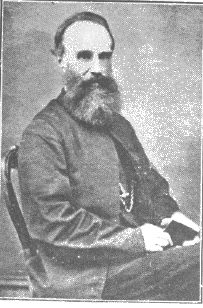
George Yonge Mould was born in Plymouth, a town in the County of Devonshire in England, on 14th February 1817. His father John Rawe Mould, a Naval Captain lived in Plymouth but his ancestors came from the town of Fowey in the county of Cornwall. Uprooting himself from his family's Royal Navy background George studied medicine at Trinity College, Dublin, and the University of King James
the Sixth, Edinburgh. In 1831, the University College was awarding Diplomas of Obstetrics, GY Mould attended for 6 months and obtained his Diploma, he graduated as a physician on April 20th, 1837. On 26th September 1839 George Yonge married Maria, daughter of London Solicitor, Richard Cranch, prior to 'their embarkation for Australia on the good ship "Rajah", which delivered them to Sydney town on 27th April 1840. Nothing more is known of the new settler’s activities until 11th August 1841 when their first child, George Gore Mould was born at 'Gilmour', Lake Bathurst, Tarago, the home of Admiral John Gore to whom we think had been known to George's father, back home in Devonshire. Apparently George was gaining Colonial experience from
John Gore, as 4½ years later on 5th February 1846, a second son, Frederick John was born "near Snowy River" according to the Baptismal record; around that period John Gore was the occupier of GEEKLE run which extended from the confluence of the Eucumbene and Snowy Rivers to Hill Top, N.E of Jindabyne. Two and a half years later, on 4th September 1848, a daughter Elizabeth (Bessie) was born at "Bullumbalong", following which the growing family again wafted into oblivion for a further 41/2 years until true to form, it was left too young William Richard on 4th March, 1853 to cause an announcement that his
parents abode was "Buckenderry". Since their arrival in Sydney, George carried out his services as a medical man on horseback, and became widely known, especially on the western Monaro. Records state that in 1845 he rode his horse across the flooded Snowy River at Jindabyne, (where the low level SMA bridge is now erected), to attend to a Mrs Williamson, delivering the first white child born south of the Snowy River. In 1858 he is still recorded at Buckindery, having signed a Partition in regard to dividing the Monero Electorate. Similarly in 1859 GY Mould of Buckindery signed a petition to Alexander Hamilton of Woolway, asking that gentleman to allow himself to be nominated as a candidate to represent Maneroo in Parliament. He still had an interest in the
property at Buckindery on 11th February 1865 when an appraisement of runs of Crown lands on the Monaro was made, it included: Buckendery – G Y Mould 30 pounds.
In 1862, G Y Mould purchased a general Store in Old Adaminaby (then known as Seymour). The store had been build by Frederick Michael Stokes the previous year. With his wife Maria, they ran it until 1866 when he sold it George and Sam Mackay (they leased it for a term to Hinton Bros. And then ran it themselves). During this period, he
continued his medical services. Their eldest son George ran the property while they were in the Store, which was some twelve miles away. On March 15th 1862 he is listed as a licensed spirit merchants in the Cooma district. On April 8th 1865, GY Mould of Adaminaby was gazetted as a "Sydney Mail Agent" and on Feb. 2nd 1866, he was amongst a list of persons, including Post Masters, to sell stamps under the Stamp Duties Act.
Mrs G.Y. Mould laid the foundation stone of the first church in Adaminaby on
November 12, 1862. There is in existence a trowel made by an early German settler, inscribed with the following inscription: "Presented to G.Y. Mold (wrong spelling) by the trustees of Seymour Established Church upon the official stone-laying ceremony, follows the year, But the date is partly obliterated. Mrs. Mould did the actual laying of the foundation stone on this occasion, and it was thought that she was the first white woman ever to cross the Snowy River. The church was opened for worship on June 14, 1863, and was named the Church of Saint John the Evangelist. The Rev. Thomas Druitt, Pastor;
Messrs. George Yonge Mould, George Barrett, and Archibald Reynolds were the Trustees" It was built out of wooden material (Mountain Ash) coming from an old hotel built at Providence. It remained as a Church until 1907 and as a Church Hall until 1941. After the present church was built, it continued in use as a Sunday School Hall until 1941. GY Mould was a generous man; there are many entries in the Sydney Church House Reports 1859-1865 of him donating 5 pounds annually. On 5th June 1864 Premises occupied by Mr Simon Freebody at Adaminaby known as Seymour Inn were entirely destroyed by fire,
and a digger, who was staying there for the night, was burnt to death. Mr Freebody was severely burned, his furniture and money were lost, himself, wife and family only escaping in a half-naked state. It is recorded that the house was the property of Dr Mould and believed to be uninsured. By now he was well known and respected in the district and he had obviously been very involved in politics. In November 1870 the "Monaro Mercury" relates "that almost the principal topic of conversation during the past week has been in connection with the forthcoming elections (representation of Eden). No less than 13 candidates have been named, consisting of Messrs. W Grahame, A. Montague, James Hinton, M Joseph, G Y Mould and etc………. Towards the end of the week the number dwindles down to
three gentleman viz. Messrs. Graham, Wood and Dawson……Woods was elected.
Emily Thickness came to Monaro as a Governess and was friendly with the daughter of the Moulds and evidentially helped teach the family as she had recently come from being educated in England. She must have proved a treasure to Mr Mould as they were married on 10/12/1870 at Camberwarra (South Coast). Not long after they moved to Cooma, leaving the property under the supervision of George Gore once again. In 1874 the
Sydney Morning Herald reports Mr Mould and his son assisting the Rev. Druitt and his wife who had met with serious accident in their buggy, between Christchurch and Mr Wilford’s residence. " no bones were broken………..the buggy was smashed to atoms." GY Mould was always busy in community affairs such as the hospital, politics, the School of Arts and the Masons. He was a great talker, often reported engrossed in discussions about the future of Monaro. His interested in politics continued, the Sydney Morning Herald, on Dec 28th 1874, records that the nominations for the Monaro electorate had taken place including the proposal of Mr D O'Connell by Mr G Spring and Sec. By Mr Mould, 'a show of hands favoured Mr Montague' and he won the election with a majority of 562. There were a group of shops in Massie Street (Opposite Cohen’s Hotel) at that time, which were demolished in 1902 when Henry Brae built Solomon's Store there. This is now Mitre 10. at that time. Another 1875 advertisement has him advertising as a Land Agent, it reads: G. Yonge Mould - Land Agent & c. - Cooma. - Office:- Opposite Cohen’s Hotel. It should
be noted at this stage that Cooma had a population of only 492 at this time. At this time he also set up as a chemist and dentist at the same address, as evidenced by this advertisement in the "Cooma Express" of August 7th, 1875. Under "Medical": Cooma Dispensary. So the evidence suggests that from 1871 to his death in 1883 George Yonge Mould was engaged in the newspaper business, in real estate, dispensing and dentistry. His second family was arriving and they had seven daughters, one died but the six Mould girls were well known in Cooma. They are recorded as living in Bombala Street in 1875, then in 1880 they moved to a new house that had just been built by Joseph Hain at 7 Lambie Street next to the Lord Raglan Hotel, this house was
known as Camden Cottage and still stands today.
Came the fateful year 1883. The death of the old "Dr"! He was not old, as men sometimes lived; he contracted a chill from which he did not recover. Glen Hall records that 'the pen fell from his hands as he was trying to write a prescription for himself. The girls, those who were old enough always had strong recollections of the terrible time when their beloved "Pa" died. He was always "Pa" to them, although Grandma was always simply
"Mother".' G Y Mould died on 18/1/1883 aged 65 years and is buried at Christ Church cemetery, Cooma. Evidentially the family had come upon hard times, as there was an ‘Entertainment’ held by Cooma Minstrels on 26th and 27th January 1883. All concerned worked very hard to give the Widow a good benefit. Mrs Mould and family went back to her family on the South Coast where she started a school. Emily died in 1936,
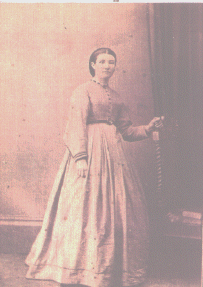
Maria Mould (nee Cranch)
In 1854 he was reported to be with Robert Cassells at Buckinderra and that he took over from Mr. F. J. Squires, an area of about 5000 acres, timbered hill and broad open valley across the plain a few miles from Adaminaby. A bank-teller in the early sixties, sent from Melbourne to the gold fields, landed at Eden and had to make his way overland via Begs and Cooma, to his appointment. He travelled horseback of coarse. Writing the account of his trip to the fields he mentions: - "Stayed the next night at Dr. Mould's place where I was received with the greatest hospitality, in marked contrast to the
previous camp, where they set the dogs on me." Thus was "Dr. M" known throughout the area. Kindly, hospitable, always available when sickness or accident occurred, never charging a fee for his services, no doubt, some people found other ways of rewarding him.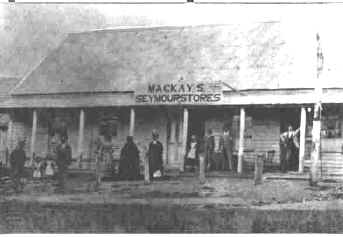 Adaminaby Store
Adaminaby Store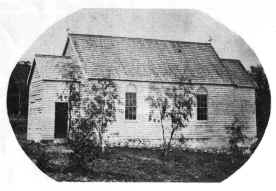 St Johns Adaminaby
St Johns Adaminaby
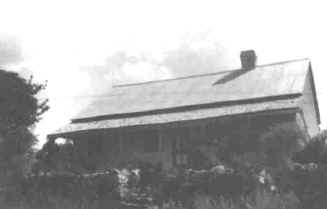 The Original Boconnoc Homestead
The Original Boconnoc Homestead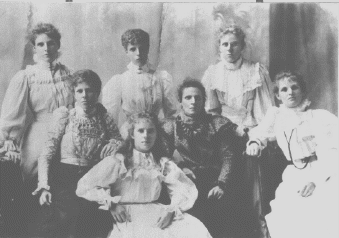 Emily Mould with her daughters
Emily Mould with her daughters
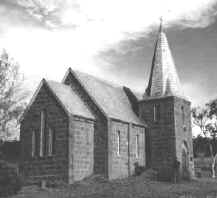
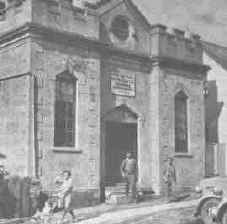 The School of Arts
The School of Arts
We are not sure how long he was involved in the publishing business. But it is recorded that in August 1875 the "Cooma Gazette" was printed and published by the proprietor, George Yonge Mould at the Cooma Gazette Office, Massie Street, Cooma."
G. Yonge Mould, of Trinity College, Dublin and of the University of Edinburgh, having now received a large and valuable supply of drugs, chemicals and c. has opened a dispensary in Cooma to which he proposes to devote all his attention.
The establishment will be conducted in the same manner as is usual in a chemists and druggists shop in London and Sydney.
Prescriptions and receipts accurately dispensed.
Teeth extracted, sealed, filled or Artificial Teeth supplied.
Perfumery & c. Monaro Baking Powder.
 Camden Cottage, Lambie Street, Cooma
Camden Cottage, Lambie Street, Cooma
|